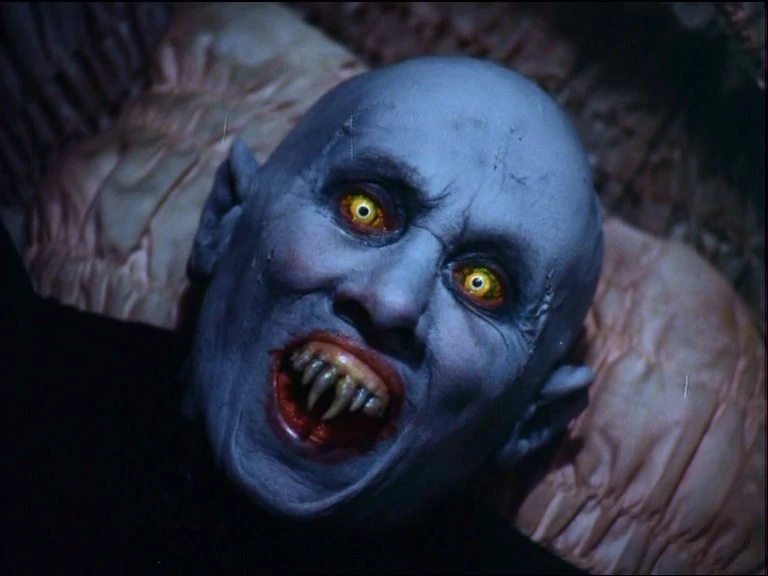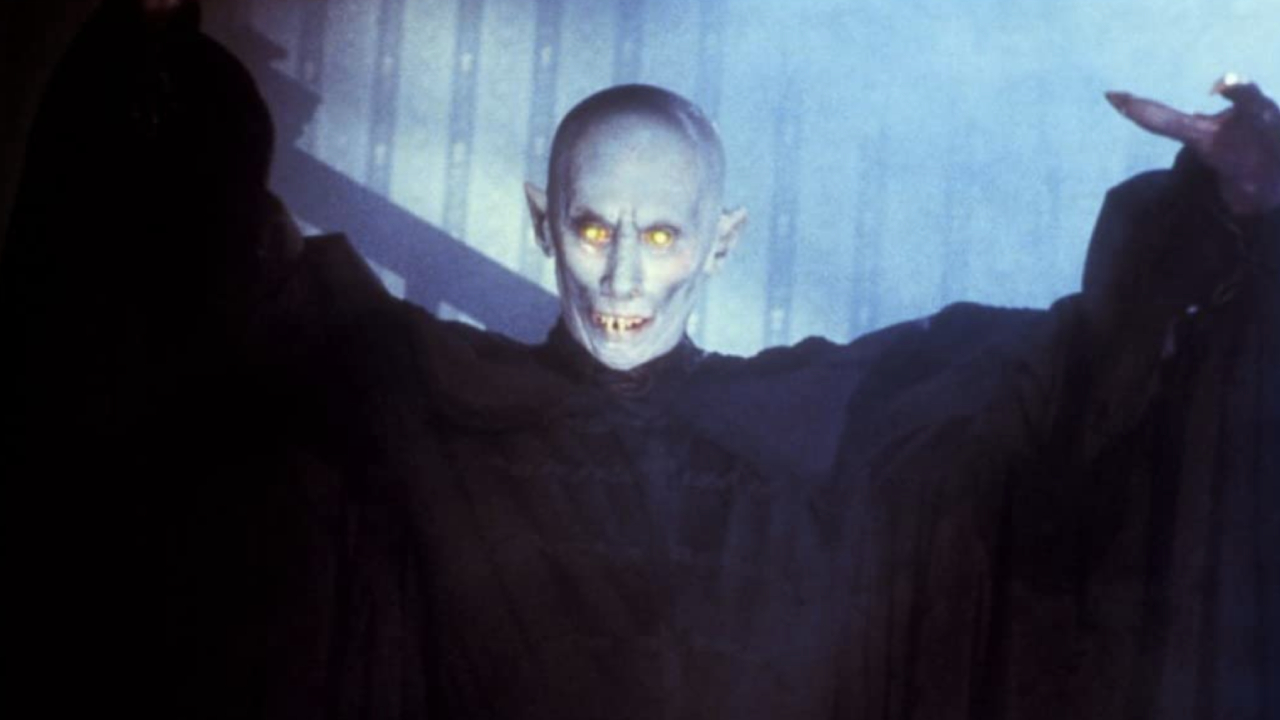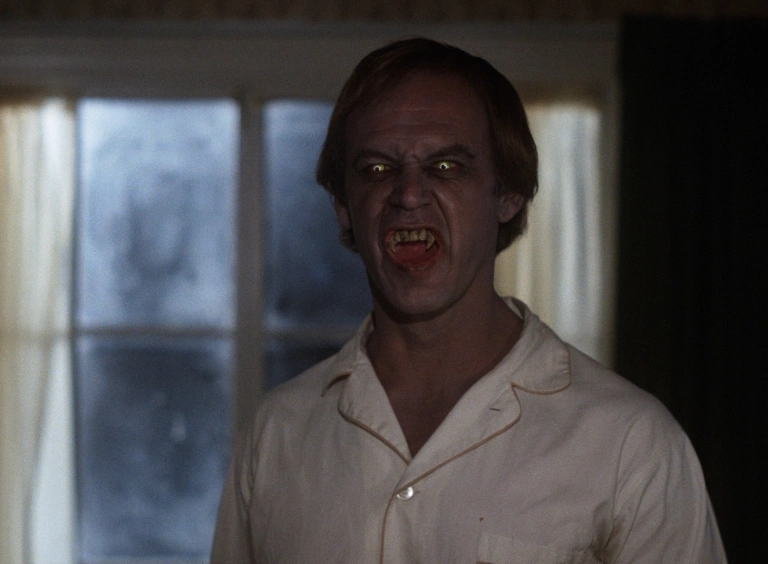The beloved horror classic Salem’s Lot. The Stephen King book Salem’s Lot, which was released in 1979, served as its inspiration. It was only three years after the triumph of Stephen King’s Carrie as a movie that it was made into a two-episode miniseries. The show, which aired on November 17 and November 24, 1979, lasted 3 hours and 20 minutes without commercials.
Only three of the four accessible cuts for the series are available. The first is the original, which was shortened by an hour after the 1970s to make room for advertisements. Post-1970s price increases in advertising contributed to this. But this rebroadcast version has never been made available separately.
The show is DVD and Blu-ray releases are the fourth and most widely distributed version, whereas the third cut was designed for theatrical presentations. The first episode’s end credits and the second episode’s opening credits were removed in the fourth cut, thereby turning the miniseries into a movie.
Salem’s Lot Explored

In a church in Guatemala, the movie begins. We observe a man, later identified as Ben Mears, and a little child, Mark Petrie, putting holy water into bottles. Unexpectedly, a bottle begins to light blue, signalling the presence of something paranormal. Mears claims that he had a premonition that “they have found us.” Then, the scene shifts, and we enter a flashback to learn how it all began.
We go two years into the past when Ben Mears, a well-known novelist, visited the little hometown of Salem’s Lot, Maine. He used to live there as a child and was revisiting it for the first time in a while. We see Mears trying to rent a big house called Marsten House, which is really creepy looking but beautiful.
However, when he talks to the broker about it, he discovers that another newcomer has come to the area and rented it. This newcomer is the enigmatic Mr. Richard Straker, who is setting up an antique shop in the neighborhood with a frequently talked about but never seen before business partner, Mr. Kurt Barlow.
Fun fact, the Marsten Residence is actually just a really large facade attached to a smaller, pre-existing hilltop house. The producers spent about $100,000 on building the facade in total. For that sum, back in 1979, they could have just built a whole house (yes, including the interiors).
So, as an alternative, Mears settles into a boarding home in the neighborhood which Miss Eva Miller owns. He then goes out to explore the neighborhood, where he meets a beautiful woman, Susan Norton, who is incidentally reading one of his books in the park.
They decide to go on a date. But before they go, he meets Susan’s father, Dr. Bill Norton, and his mother. Meanwhile, a police officer asks a drunkard on the street to keep an eye on Mears. I know, it all seems a little weird and extra, but it really helps add to the small-town atmosphere. It’s an immersive experience in the movie and helps one feel like they are right there in Salem’s Lot.
The next day, Mears goes to his old school and meets his old teacher Jason Burke. There, he confides in Burke that he believes the Marsten House is a haunted or evil place, and he has believed that since its first owner, Hubie Marsten, lived there. Hubie was thought to have molested children, and he committed suicide there. Mears also remembers a terrifying experience from his youth, when he broke into the home on a dare and claims to have encountered Hubie’s spirit.
While he is at his old school, he finds out about Mark, who also seems to be a budding writer. Mark had been writing a school play on Salem’s Lot. If one listens closely, one can find out about the history of Salem’s Lot. Later, we see Mark and his friends practicing at his house for the play.
Mark is a horror movie buff with a lot of paraphernalia, like ghoul masks. His friends Danny and Ralphie leave before dinner, but they decide to be adventurous and take a shortcut through a forest. It was obviously not a good idea because a mysterious cargo was being delivered for Mr. Straker that very night. It later turns out that Kurt Barlow, Straker’s famously heard of but not seen business partner, was inside the box. On a side note, a separate small town story is also going on where the local relator is having an affair with his secretary.
After that night, townspeople start to vanish or die in mysterious ways. Mears and Straker are seen as the primary suspects because they are both new to the area. However, in reality, it is Barlow who is the killer. He is an old vampire who traveled to Salem’s Lot inside the cargo box after dispatching Straker to prepare a path for him. So yeah, Barlow and his vampirism are the cause behind all these deaths.
The first death is of Ralphie Glick. As a gift to Barlow in order to satiate his hunger, Straker had kidnapped Ralphie Glick, making him the first to turn into a vampire. After that, Barlow goes on a killing spree and murders the local realtor, Larry Crockett… the same guy who was having an affair with his secretary.
Funnily enough, the only reason that Larry was out that night was that he was going to meet his secretary. Ralphie later reappears as a vampire in front of his brother Danny through the window in a really creepy scene. To create a more unsettling atmosphere for this scene, several of the sequences of young vampires hovering outside the windows of their victims were shot backwards. The actors also decided to use a boom crane for these scenes instead of being suspended on a wire, like they do traditionally.
Obviously, Danny dies. Following his burial, Danny, who is now a vampire, infects a cemetery worker called Mike Ryerson as well. The entire town is slowly getting infected, and the newly infected are the reason why. Danny then tries to feast on Mark Petrie, the genius boy writer who is a horror buff. Mark uses a crucifix and turns him away. So yeah, that doesn’t work out well for Danny.
Mears, Dr. Norton, and Burke eventually become aware of what is happening to the community as vampirism spreads and they make an effort to try and stop it. Marjorie Glick, Ralph and Danny’s mother, who was actually thought to be dead, attacks Ben Mears as she awakens on a post-mortem table. Ben is able to defend himself with a handmade crucifix. Meanwhile, Mark flees with the aid of a priest after Barlow kills both of his parents. Poor boy turns into an orphan in just one night, and loses both his friends too. Burke, however, gets a serious heart attack after coming into contact with Ryerson, who has just become a vampire.
Mark then decides to enter our villainous location, the Marsten House, seeking retribution for the murders of his parents… and dear lovely Susan follows him out of worry. Both are quickly found and held by Mr. Straker. Later, Mears and Susan’s father also enter the house in search of the two. By this time, obviously, Straker has an idea that people have figured things out and are coming to the house. So, he murders Norton by spearing the poor man on a pair of antlers. Ben Mears, in both survival and revenge, shoots him and ends up killing him.
The party then searches for Barlow, our ancient vampire. A stake is driven through Barlow’s heart to kill him when Mears and Mark finally manage to find his coffin, which is somehow still in the cellar. The two light the Marsten property on fire, along with all the other infected residents-turned-vampires, and run away into the night. But Susan is missing throughout the scene. The wind drives the flames toward the town while the Marsten house burns. Mears says, “The fire will drive all the vampires from their hiding places and purify the town from the evil that has engulfed it,” as he and Mark leave Salem’s Lot.
The flashback ends, and we are back in the narrative at the church with Mears and Mark. They are very clearly still on the run from the vampires. However, it seems that they have been found again, as shown by the fact that their holy water bottles start to glow blue whenever a vampire is around.
Ben and Mark head back to their little motel to get their possessions and get back on the run after realizing that they have been located again. However, this time there is a plot twist. When the party arrives, they discover Susan in Ben’s bed. She gets ready to bite him while he leans in for a kiss. So clearly, the fire had not worked well enough, and she had transformed into a vampire.
But Mears is clearly a man of steel and great self-control. He chooses to pierce her heart with a stake and kill her instead of turning into a vampire like her. But ultimately, he is also just a man. He is devastated to have lost the one he thought to have loved, but he soldiers on and flees with Mark even though they know in their hopeless hearts that the vampires will probably still follow them and find them somehow.
Stephen King was actually quite pleased with this adaptation, despite the fact that it significantly departs from the book in many ways, most notably in how Mr. Barlow, the head vampire, is portrayed.
Difference Between King’s 1979 & 2004 Miniseries

While Hooper’s Salem’s Lot, which was the original mini-series set in 1979, sets up the start with a flashback to the main story filled with horrors and leaves hope for a sequel. On the other hand, Salomon’s Salem’s Lot, which was made in 2004, starts with Ben attacking a priest and ending up in a hospital bed. In the hospital, he tells the story of what happened when he went back to Salem’s Lot.
The beginning is a little pointless in this one because it merely introduces Ben, which could have been done in the same way as it did in the novel. In the novel, Ben Mears arrives in Salem’s Lot to start writing his next book. It could have been as simple as that. There is no exciting beginning in the book, because Stephen King likes to slowly build up his horrors. It’s possible that both the mini-series made one in order to hook viewers, because it is not always easy to up the story’s horrors gradually when making tv shows or movies.
The two storylines are so entirely different that even their main characters also differ in nature. In Salomon’s adaptation, Ben is forced to return to Salem’s Lot, Maine, because he is unable to flee his trauma. In contrast, Hooper’s Ben establishes his relationship with the community and the Marsten home in a far more modest manner. One can even call his interactions boring.
Throughout the mini-series, Rob Lowe’s character (the one in the 2004 version) doesn’t hold back. He is often stopped in his tracks by flashbacks of his early life in the eerie Victorian house. He is deeply flawed but believable as a character. Salomon created a sympathetic character whose slight arrogance exposes a serious defect. As a result, he was far more credible than Hooper’s Ben Mears was, even though he seemed to be more likable in the series.
The biggest difference between the two has to be their portrayal of our beloved vampire Mr. Barlow. Reggie Nalder plays him as the recognizable bluish-white-faced vampire that moves into the Marsten home in Hooper’s Salem’s Lot. Whereas Salomon’s Barlow is played by Rutger Hauer and depicts a more authentic source vampire. He adopts the conventional vampiric appearance of a fanged human rather than a ghostly visage. Salomon’s Barlow adheres more closely to the original and conventional vampire concepts.
Still, it does not necessarily mean that it helps heighten the horrors of the mini-series as a whole. In fact, due to his creepy visage, many fans consider the 1979 version of Barlow to be more horrifying. Emerging from the shadows and into the light with an indelible glare that can only be interpreted as a craving for blood is a lot more horrific than just a fanged man. Hauer’s portrayal is more akin to that of Dracula, you know, a charming but shady-looking gorgeous and affluent guy.
Next, we come to the setting. The setting is a crucial element in all horror films, especially the horrors that occur in Stephen King’s books. For instance, the entire town of Derry, Maine, is a major antagonist in his classic novel ‘It’. Salem’s Lot, Maine, serves as a center for the manifestation of evil in a similar manner. However, the details in Hooper’s mini-series alter significantly from those in Salomon’s yet again.
Salem’s Lot from 1979 focuses on adulterers, child abusers, and vampires, but the mood in 2004 isn’t as powerful. Instead, it makes an excessive effort to modernize everything. Salomon’s mini-series concentrates on placing the narrative in a modern environment, which doesn’t necessarily assist it as a whole. In contrast, Hooper’s mini-series focuses on making Salem’s Lot gloomy and spooky with a dramatic gothic flair which worked a lot better for the series and its impact.
So yes, the two are significantly different.
Marvelous Verdict

We think both the stories are brilliant. The original is quite slow. However, we must admit, we are partial to the original. But hey, that’s just us. You guys might like the 2004 version more if you are into conventional portrayals of vampires. Overall, the Marvelous Verdict is that both are brilliant mini-series that one should definitely think of watching, especially if you’re into vampires. I would say they are a solid 8/10.
